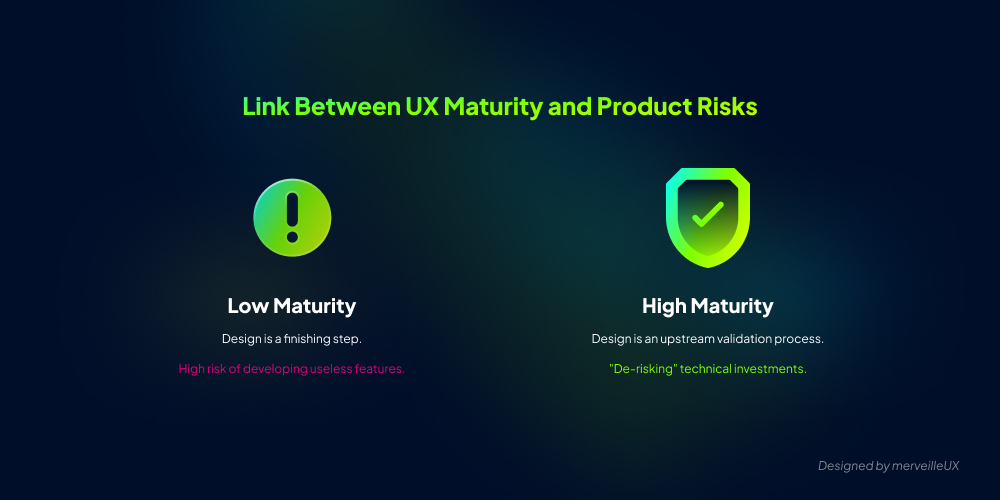Launching a SaaS is a massive milestone, but scaling it requires a completely different engine. The scrappy tactics that convinced your first 100 users often become the very bottlenecks holding you back from the next 10,000. This is where UX Maturity comes into play. Far from being an abstract academic concept, this model—theorized by the Nielsen Norman Group—is a concrete steering tool for leaders. It helps you objectively benchmark your organization: is design just a final coat of paint in your process, or is it a structured engine driving your growth? Let’s break down these stages to identify where you stand and how to reach the next level.
Table of contents
What is UX Maturity (and Why is it a Business KPI)?
There is a common confusion in the SaaS world: people often think that the quality of a product's design depends solely on the talent of the designers hired. This is a misjudgment. You can hire the best talent on the market, but if they are forced to apply coats of paint to poorly defined features, their impact will be nil.
This is where the concept of UX Maturity comes in.
Defined by the Nielsen Norman Group (NNG), UX maturity doesn't grade the beauty of your interfaces. It measures your organization's ability to place the user at the center of its strategic decisions. It is an organizational health indicator that evaluates how design is integrated, budgeted, and used within your company.
A De-risking Lever for Your Roadmap
For a leader, UX maturity should be monitored like any other financial or technical KPI. Why? Because it is directly correlated with product risk.

- At low maturity, design is a finishing step. The risk of developing useless features (and thus generating "disposable" code) is high because decisions rely on hunches or unqualified client requests.
- At high maturity, design is an upstream validation process. It helps "de-risk" technical investments by ensuring that every line of code serves a verified need.
So, leveling up your UX maturity isn't about trying to make things "prettier." It's about seeking to make your development cycle more efficient, predictable, and profitable. It's moving from a logic of production to a logic of value.
The 3 Stages of SaaS Maturity (The NNG Scale Revisited)
The academic model from the Nielsen Norman Group includes 6 levels. For a SaaS leader, this granularity is often superfluous. In operational reality, a company goes through three major phases of maturity. Identifying which one you are in is the first step to progress.

Stage 1: "Cosmetic" UX (Levels 1 & 2)
This is the default stage for many projects in the Seed phase or driven by an exclusively engineering culture.
- The Symptom: Design is perceived as a finishing layer. You often hear: "Make it look clean" once the feature is already coded. In the most extreme cases, developers make interface decisions directly in the code, or a freelancer steps in briefly at the very end.
- The Operational Reality: Decisions are based on the internal team's opinions ("I prefer blue") rather than user needs.
- The Business Risk: You are accumulating visual and functional debt. The product works technically, but adoption is low because usage is counter-intuitive. The cost of rework (redoing what was poorly designed) is high.
Stage 2: "Tactical" UX (Levels 3 & 4)
This is generally the stage reached by startups in the acceleration phase (Series A). The company has understood the importance of design and structured its teams.
- The Symptom: Execution is good. There are in-house designers, established processes, and often the start of a Design System to ensure consistency. Interfaces are professional and standardized.
- The Operational Reality: Design is well done, but it often arrives too late. The design team works in reaction to a roadmap defined by sales or technical leadership. You optimize existing features, smooth out flows, but you don't question the relevance of the requested features.
- The Business Risk: The glass ceiling. You have a beautiful product, but you struggle to innovate or significantly reduce churn because you are solving... problems that may not be priorities for your users.
Stage 3: "Strategic" UX (Levels 5 & 6)
This is the level of market leaders (like Slack, Linear, or Airbnb), where design is a fully-fledged growth engine.
- The Symptom: User research (UX Research) feeds the strategy before a single line of code is written. Design is no longer a support service but a business partner.
- The Operational Reality: Decisions are "Data-Informed." You don't launch a feature because the CEO decided so, but because research validated a need and a solution. UX is measured with precise KPIs (task time, success rate, adoption).
- The Business Risk: At this stage, risk decreases drastically. Technical investment is secured because you only develop what has proven value. This is where UX becomes a major competitive advantage that is impossible to copy quickly.
Self-Diagnosis: What Are the Symptoms of Your Current Level?
Theory is one thing; reality on the ground is another. It is easy to overestimate your UX maturity because you hired a designer or bought a Figma license.
To find out where you really stand, forget job titles and observe the dysfunctions in your daily operations. Here is the truth test.
You are at Stage 1 (Cosmetic) if:
- Your customer support is a financial sinkhole: This is the most costly symptom. Your revenue increases, but your support payroll does too. You have to hire agents linearly to compensate for an interface that isn't self-explanatory. Your margin doesn't improve with scale.
- Your developers improvise the UI: Lacking precise mockups or ready-to-use components, your devs have to invent the interface while coding. Result: visual inconsistencies and (very expensive) engineering time spent on CSS.
- Your sales reps "hide" certain parts of the product: During demos, your Sales team carefully avoids clicking on certain features for fear of the "bloatware" effect.
You are at Stage 2 (Tactical) if:
- You have a Design System... that no one uses: A beautiful component library exists, but developers continue to hard-code or create duplicates due to a lack of communication or documentation.
- UX always comes at the "end of the chain": The design team is solicited once technical specifications are frozen. The designer's mission is to dress up the technical solution, not to question the problem.
- You debate opinions, not facts: Product meetings drag on over subjective preferences ("I don't like this green," "I think the user will want this") because there is no user data to settle the debate.
You are aiming for Stage 3 (Strategic) when:
- Design pays its share: You can correlate a specific UX redesign to a measurable drop in support contact rates or an increase in conversion rates.
- Research precedes the roadmap: You don't launch a line of code before validating market appetite via prototypes.
How to Cross the Gap and Level Up?
Let's be realistic: you don't go from the "DIY" level to the "Apple" level in one quarter. Increasing UX maturity is a cultural shift that requires method. There's no point in trying to revolutionize everything at once; you have to cross logical steps.
Here are the priority levers to move to the next level, depending on your current situation.
From "Cosmetic" to "Tactical": Stop the Technical Bleeding
If you are at Stage 1, your absolute priority is to stop wasting development time on undefined interfaces. Your goal is standardization, to reach Product-Market Fit.
- The UX Audit: Before rebuilding, you must measure the extent of the damage. An audit allows you to objectively identify friction points that cost support money and inconsistencies that lose users. It is the document that aligns leadership on the urgency to act.
- Systematic Prototyping: Establish a golden rule: "No code without a validated mockup." By mandating the validation of a prototype (even a simple one) before development, you shift the error. Being wrong in Figma costs a few hours; being wrong in code costs weeks.
From "Tactical" to "Strategic": Industrialize Your Growth
If you are at Stage 2, your product team is running, but you are looking to scale and maximize impact. Your goal is integration.
- The Design System (The Accelerator): It's time to move from a simple UI component library to a truly governed system. A robust Design System connects design to code. It allows your developers to stop worrying about CSS to focus on business logic, drastically accelerating your time-to-market.
- Upstream User Research (De-risking): This is the hardest lever to activate, but the most profitable. Instead of using UX to validate a solution already decided upon, use it to explore the problem (Discovery). A few well-targeted interviews before launching a feature can save you three months of useless development.
Conclusion
UX maturity isn't a medal you hang on the wall to look pretty. It's a value multiplier.
As long as you stay at the "DIY" stage, every new user will cost you more to support, and every new feature will cost you more to develop. It's growth that runs out of steam on its own. On the other hand, by structuring your approach to design, you reverse the trend: the product becomes more autonomous, the technical team faster, and customer satisfaction becomes a natural engine for acquisition.
Don't let your organization stagnate on processes inherited from your early days. Scaling isn't done by working harder, but by working smarter.



